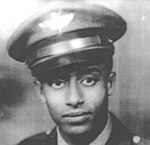William Armstrong (pilot)
Flight Officer William Armstrong | |
|---|---|
 William Armstrong in 1944 | |
| Birth name | William Pickney Armstrong |
| Nickname(s) | Will |
| Born | October 30, 1924 Providence, Rhode Island, US |
| Died | April 1, 1945 (aged 20) Austria |
| Buried | Grace Church Cemetery in Providence |
| Allegiance | United States |
| Service | United States Army Air Force |
| Years of service | 1944–1945 |
| Rank | Flight Officer |
| Unit | 332nd Fighter Group |
| Awards |
|
Flight Officer William Armstrong (October 30, 1924 – April 1, 1945) † was a member of the famed group of World War II-era African-Americans known as the Tuskegee Airmen. His plane was shot down on Easter Sunday in 1945 over Austria.[1] In 2018 he was inducted into the Rhode Island Aviation Hall of Fame.[2]
Military service
World War II

After his graduation (September 8, 1944) from the Tuskegee Institute in Alabama he was assigned to the 301st Fighter Squadron, 332nd fighter group in Ramitelli, Italy. Armstrong flew missions escorting bombers to targets in Nazi territory.[1][2]
On Easter Sunday April 1, 1945, he was among a group of Tuskegee airmen escorting bombers back to their base. The Tuskegee airmen were attacked by a group of German fighters and Armstrong's plane was one of two American planes shot down. His body was not recovered.[1]
Dogfight
The Tuskegee Airmen had a successful mission escorting bombers on a bombing mission over St. Polten, Austria April 1, 1945. Returning to base, the American planes were attacked by German fighter planes. The Tuskegee airmen broke away to take on the German fighter planes. The Tuskegee airmen were able to shoot down 12 of the German fighter planes, but two P-51s were shot down. Armstrong's plane crashed into the ground, his body was not recovered. Walter Manning was able to deploy his parachute but was subsequently lynched.[2][4]
Recovery of his body
After the war his stepfather petitioned the military to keep searching for William Armstrong's body. The Military found his remains buried in a grave in Austria and his body was flown back to Rhode Island in 1950.[2]
Awards
- Air Medal[5]
- Purple Heart Medal[5]
- Congressional Gold Medal (2007) (posthumously)[6]
- Presidential Unit Citation[5]
- European-African-Middle Eastern Campaign Medal[5]
Education
- Central High School 1943[2]
- Tuskegee Institute (1944)[1]
Personal life
He was born in Washington D.C., but he his mother Evelyn, and his sister Evelyn moved to Providence, Rhode Island where his grandfather lived. His mother married Nelson Venter.[2] The city of Providence has erected a memorial to Armstrong in Providence Rhode Island at the intersection of Dodge and Cranston streets.[7]
See also
Further reading
- The Tuskegee Airmen: An Illustrated History, 1939–1949[8]
References
- ^ a b c d "Profiles of Tuskegee Airmen: William Armstrong". redtail.org. CAF Red Tail Squadron. April 14, 2018. Retrieved February 6, 2020.
- ^ a b c d e f "2/LT William P. Armstrong". RI Aviation Hall of Fame. February 8, 2018. Retrieved February 6, 2020.
- ^ Rice, Markus. "The Men and Their Airplanes: The Fighters." Tuskegee Airmen, March 1, 2000.
- ^ Patterson, Brandon (May 27, 2018). "Tuskegee Airman honored 73 years after being lynched in Austria". Detroit Free Press. Retrieved September 27, 2019.
- ^ a b c d "William P Armstrong". honorstates.org. Honor States. Retrieved February 6, 2020.
- ^ Rangel, Charles B. (April 11, 2006). "Tuskegee Airmen Gold Medal Signed Into Law". Press Release. United States House of Representatives. Retrieved November 26, 2008.
- ^ Beale, Stephen (November 10, 2010). "Tuskegee Airman to Be Honored Today". Providence News. Retrieved February 6, 2020.
- ^ Caver, Joseph; Ennels, Jerome A.; Haulman, Daniel Lee (2011). The Tuskegee Airmen: An Illustrated History, 1939–1949. Montgomery: New South Books. p. 394. ISBN 978-1588382443. Retrieved February 6, 2020.
Notes
External links
- Tuskegee Airmen at Tuskegee University
- Tuskegee Airmen Archives at the University of California, Riverside Libraries.
- Tuskegee Airmen, Inc.
- Tuskegee Airmen National Historic Site (U.S. National Park Service)
- Tuskegee Airmen National Museum
- Fly (2009 play about the 332d Fighter Group)
- 1924 births
- 1945 deaths
- People from Providence, Rhode Island
- Tuskegee Airmen
- Tuskegee University alumni
- Military personnel from Tuskegee, Alabama
- United States Army Air Forces personnel killed in World War II
- Aviators killed by being shot down
- Aviators killed in aviation accidents or incidents in Germany
- United States Army Air Forces officers

